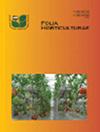Fungicides, bio-controllers and resistance inducers affect bioactive compounds and oxidative metabolism in bell pepper plants inoculated with Phytophthora capsici
IF 1.8
4区 农林科学
Q2 HORTICULTURE
引用次数: 0
Abstract
The rational use of chemical fungicides in chilli pepper (杀菌剂、生物控制剂和抗性诱导剂对接种了疫霉的甜椒植株的生物活性化合物和氧化代谢的影响
在辣椒(Capsicum annuum L.)中合理使用化学杀菌剂来控制疫霉(Phytophthora capsici Leo.本研究的目的是评估在辣椒植株中接种荚膜疫霉动物孢子后,施用杀菌剂、生物控制剂和抗性诱导剂如何影响生物活性化合物的产生和氧化代谢。统计分析表明,在使用哈茨真菌、Acibenzolar-S-Methyl(ASM)和膦酸处理的植物中,总黄酮、总酚和水杨酸的浓度存在显著差异。此外,ASM 和枯草芽孢杆菌的抗氧化能力值最高。另一方面,ASM 的应用有利于提高超氧化物歧化酶和苯基铵裂解酶的活性,其值分别为 4.42 ± 0.016(单位-分钟-1 -克-1)和 3.90 ± 0.22 U -克-1。不过,过氧化氢的产生与膦酸处理相似。同样,用枯草芽孢杆菌和 Metalaxyl-M 处理的植物显示过氧化物酶活性增加,数值从 2.86 ± 0.05 到 4.52 ± 0.02(μmol - [mg 蛋白质]-1 - min-1)不等。同样,经膦酸处理的植物也表现出较高的过氧化氢酶活性,其值从 2.38 ± 0.032 μmol H2O2 - min-1 - g-1 到 4.30 ± 0.024 μmol H2O2 - min-1 - g-1。补充使用具有生物和抗性诱导功能的产品有助于减轻因使用化学杀菌剂控制辣椒上的辣椒疫霉菌而对环境造成的影响。
本文章由计算机程序翻译,如有差异,请以英文原文为准。
求助全文
约1分钟内获得全文
求助全文
来源期刊

Folia Horticulturae
Agricultural and Biological Sciences-Horticulture
CiteScore
3.40
自引率
0.00%
发文量
13
审稿时长
16 weeks
期刊介绍:
Folia Horticulturae is an international, scientific journal published in English. It covers a broad research spectrum of aspects related to horticultural science that are of interest to a wide scientific community and have an impact on progress in both basic and applied research carried out with the use of horticultural crops and their products. The journal’s aim is to disseminate recent findings and serve as a forum for presenting views as well as for discussing important problems and prospects of modern horticulture, particularly in relation to sustainable production of high yield and quality of horticultural products, including their impact on human health.
 求助内容:
求助内容: 应助结果提醒方式:
应助结果提醒方式:


